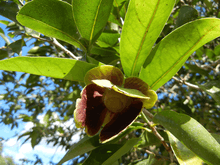Mosannona depressa
Mosannona depressa is an evergreen tree within the Annonaceae family native to tropical southern Mexico, Belize, Guatemala, and Honduras.
| Mosannona depressa | |
|---|---|
 | |
| Flower and leaves of Mosannona depressa in the Yucatán | |
| Scientific classification | |
| Kingdom: | Plantae |
| Clade: | Tracheophytes |
| Clade: | Angiosperms |
| Clade: | Magnoliids |
| Order: | Magnoliales |
| Family: | Annonaceae |
| Genus: | Mosannona |
| Species: | M. depressa |
| Binomial name | |
| Mosannona depressa | |
| Synonyms | |
English common names include lancewood and wild soursop. Spanish common names include elemuy and yumel.[3]
Botany
A mature tree is generally 6-10 m (19-32') tall.
Chemistry
The bark contains significant amounts of alpha-asarone, but not its carcinogenic isomer beta-asarone, and other related trans-Propenylbenzene compounds.[4]
Medicinal Use
The bark of this tree is used by many people where it is native as medicine for gall stones.[5] The root, cooked with corn silk, was reported used to treat gonorrhea and kidney and bladder problems.[6]
Some more modern studies suggest this herb might have cholesterol-lowering properties.[7]
Toxicology
Extremely high doses (60 mg/kg) of pure alpha-asarone extracted from lancewood caused significant maternal harm when fed to pregnant mice. At doses of 15, 30 and 60 mg/kg, this compound was lethal to embryos and teratogenic.[8] These concentrations are far beyond what can be achieved using the plant as medicine and therefore has no bearing on whether or not it would cause problems in pregnancy.
References
- "IUCN Red List of Threatened Species". International Union for the Conservation of Nature. 2020. Retrieved 2020-03-15.
- "Mosannona depressa (Baill.) Chatrou". Plants of the World Online. The Trustees of the Royal Botanic Gardens, Kew. n.d. Retrieved July 10, 2020.
- Wiersema, JH; León, B (2016). World Economic Plants: A Standard Reference, Second Edition. Boca Raton, FL: CRC Press. ISBN 9781439821428.
- Enqíques RG, Chávez MA, Jáuregui F (1980). "Propenylbenzenes from Guatteria gaumeri". Phytochemistry. 19 (9): 2024–2025. doi:10.1016/0031-9422(80)83029-9.
- Chamorro G, Salazar M, Salazar S, Mendoza T (Nov–Dec 1993). "Pharmacology and toxicology of Guatteria gaumeri and alpha-asarone". Rev Invest Clin (in Spanish). 45 (6): 597–604. PMID 8159883.CS1 maint: date format (link)
- "Mosannona depressa". Tropical Plants Database. 2020. Retrieved 2020-03-15.
- Resendiz JS, Lerdo de Tejada A (1982). "Cholesterol-lowering effect of Guatteria gaumeri (preliminary report)". J Ethnopharmacol. 6 (2): 239–242. doi:10.1016/0378-8741(82)90006-x. PMID 7132402.
- Salazar M, Salazar S, Ulloa V, Mendoza T, Pages N, Chamoro G (Aug 1992). "Teratogenic action of alpha-asarone in the mouse". J Toxicol Clin Exp (in French). 12 (3): 149–154. PMID 1453351.
